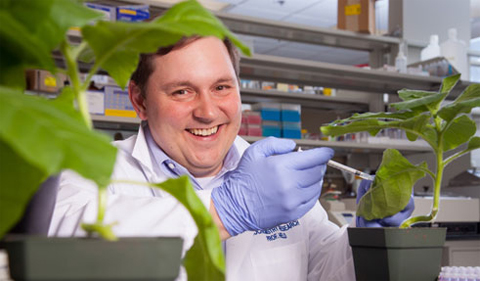Dr. Michael Held and Dr. Marcia Kieliszewski collaborated with researchers from the University of Sussex and the University of Georgia on two journal articles.
Kieliszewski is Professor of Chemistry & Biochemistry at Ohio University, and Held is Associate Professor there. Their co-authors are DTA Lamport of the University of Sussex and L. Tan of the University of Georgia.
Their most recent article is “The Role of the Primary Cell Wall in Plant Morphogenesis” in the Journal of Molecular Science.
Abstract: Morphogenesis remains a riddle, wrapped in a mystery, inside an enigma. It remains a formidable problem viewed from many different perspectives of morphology, genetics, and computational modelling. We propose a biochemical reductionist approach that shows how both internal and external physical forces contribute to plant morphogenesis via mechanical stress⁻strain transduction from the primary cell wall tethered to the plasma membrane by a specific arabinogalactan protein (AGP). The resulting stress vector, with direction defined by Hechtian adhesion sites, has a magnitude of a few piconewtons amplified by a hypothetical Hechtian growth oscillator. This paradigm shift involves stress-activated plasma membrane Ca2+ channels and auxin-activated H⁺-ATPase. The proton pump dissociates periplasmic AGP-glycomodules that bind Ca2+. Thus, as the immediate source of cytosolic Ca2+, an AGP-Ca2+ capacitor directs the vectorial exocytosis of cell wall precursors and auxin efflux (PIN) proteins. In toto, these components comprise the Hechtian oscillator and also the gravisensor. Thus, interdependent auxin and Ca2+ morphogen gradients account for the predominance of AGPs. The size and location of a cell surface AGP-Ca2+ capacitor is essential to differentiation and explains AGP correlation with all stages of morphogenetic patterning from embryogenesis to root and shoot. Finally, the evolutionary origins of the Hechtian oscillator in the unicellular Chlorophycean algae reflect the ubiquitous role of chemiosmotic proton pumps that preceded DNA at the dawn of life.
They also authored “Pollen tube growth and guidance: Occam’s razor sharpened on a molecular arabinogalactan glycoprotein Rosetta Stone” in New Phytologist.
Abstract: Occam’s Razor suggests a new model of pollen tube tip growth based on a novel Hechtian oscillator that integrates a periplasmic arabinogalactan glycoprotein-calcium (AGP-Ca2+ ) capacitor with tip-localized AGPs as the source of tip-focussed cytosolic Ca2+ oscillations: Hechtian adhesion between the plasma membrane and the cell wall of the growing tip acts as a piconewton force transducer that couples the internal stress of a rapidly growing wall to the plasma membrane. Such Hechtian transduction opens stretch-activated Ca2+ channels and activates H+ -ATPase proton pump efflux that dissociates periplasmic AGP-Ca2+ resulting in a Ca2+ influx that activates exocytosis of wall precursors. Thus, a highly simplified pectic primary cell wall regulates its own synthesis by a Hechtian growth oscillator that regulates overall tip growth. By analogy with the three cryptic inscriptions of the classical Rosetta Stone, the Hechtian Hypothesis translates classical AGP function as a Ca2+ capacitor, pollen tube guide and wall plasticizer into a simple but widely applicable model of tip growth. Even wider ramifications of the Hechtian oscillator may implicate AGPs in osmosensing or gravisensing and other tropisms, leading us yet further towards the Holy Grail of plant growth.





















Comments